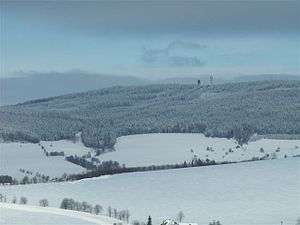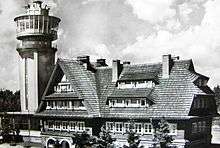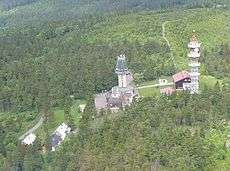Suchý vrch
Suchý vrch German: Dürrer Berg; Polish: Suchy szczyt (Dry hill); (995 metres) is the highest (double-peaked) mountain of Bukovohorská mountains, eastern part of Orlické Mountains, Moravia and Bohemia Czech Republic. Located on the historical border between Bohemia and Moravia, and right on trace where runs line of drainage divide of main European watershed (Elbe - North sea and Danube basin - Black sea).
| Suchý vrch | |
|---|---|
 Winter view of Suchý vrch | |
| Highest point | |
| Elevation | 995 m (3,264 ft) |
| Coordinates | 50°3′2″N 16°41′38″E |
| Geography | |
 Suchý vrch Location in the Czech Republic | |
| Location | Bohemia, Moravia, Czech Republic |
| Parent range | Orlické hory part Bukovohorská mountains |
The average annual temperature is about 2,5 °C. A radio re-transmitter is situated on the top. The upper platform is used as a watchtower. The mountain is also a popular area for skiing.
History

.
The first construction on the mountain was a simple cabin in 1925, as refuge for mountain hikers. In 1928, a mountain hotel was built after the design of architect Jaroslav Stejskal. It was called Kramářova chata (Karel Kramář mountain hut) and had a concrete watchtower 28 metres high.
After World War I, the rising nationalism within both the Sudeten German Tourist Association and its Czech-speaking rival, Klub českých turistů (Czech hikers club) prompted each group to attempt to outdo one another at each mountain peak, with facilities that accommodated hiker lodgings and watchtowers. This activity seemed to identify the Germans as pioneers of mountain tourism and the Czechs good learners.
On 26 August 1937 he lunched where President Edvard Beneš as inspector supreme for the control of border defense fortification, against the aggression of Hitler.
The Bradlo (Klippe) is a slate stone formation in the Orlické hory mountain range of the Czech Republic, near the higher peak. In the Middle Ages, people feared the place, believing witches lived there. The area is home to many rare plants, so it is not open to the public.[1]
Geology
The entire massif consists mainly by moldanubic, i.e. series of rocks generated during sedimentation in precambric sea and wrinkled later into mountain chains and composed of crystalline slates and schicht gneiss (a metamorphic rock with foliations), mica schicht and quartzite. Rocks in the syntectonic migmatite of the Orlické mountains create Suchý vrch shortly beforeprecambric period.
The summit is a round and smooth, jagged edge nacked vertical rocks (Bradlo) no more than 12 m (39 ft) in height
Flora
Summit is covered by alpine meadow, and all hill sides forested by spruce forest. Plants: False lily, fern bracken, western oakfern, and lot of bilberryes.

Watchtower
The observation tower and later re-transmitter was built between 1931-32 by design of architect A. Patrmann. The Krkonoše, Malá Fatra Mts. and Alps can be seen from the observation tower platform.
Surrounding
3 km to north is located heavy bunker (artillery fortress) of Czechoslovak defensive border fortifications - World War II (called also "Czech Maginot line") Bouda (booth) with branching infantry underground system including barracks, and other underground facilities (casemats), such as command posts resp. Tactical Operations Centers, munition storrage, munition workshops, field clinic, engine rooms, underground railway, ventilation and filtration system, artesian wells etc..
References
External links
| Wikimedia Commons has media related to Suchý vrch (Orlické hory). |